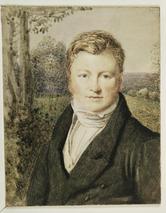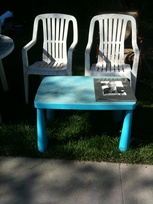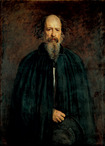day by day: a blog
July 21, 2009
family business
 [image: John Varley (1778-1842), by John Linnell] Sometimes, as cell by solitary, database cell I monotonously and relentlessly build up the genealogical reef that is the Family Ghosts website, I get the feeling, slightly Pynchonesque in a paranoid way, that every intellectual affiliation is subtended by an occult family connection.
[image: John Varley (1778-1842), by John Linnell] Sometimes, as cell by solitary, database cell I monotonously and relentlessly build up the genealogical reef that is the Family Ghosts website, I get the feeling, slightly Pynchonesque in a paranoid way, that every intellectual affiliation is subtended by an occult family connection.
Take W. B. Yeats’s well-known fascination at the end of the 19th century with the works of Blake and Shelley. Critics have usually parsed this passionate interest in the visionary strain of Romanticism either as being Yeats's way of disaffiliating himself from his father's mid-Victorian rationalism or as being symptomatic of the common Anglo-Irish obsession with the supernatural. Or, of course, as being both.
Yet it has apparently escaped notice that to the young Yeats Blake and Shelley must have been almost living, breathing presences, alive to him through a family tie. Yeats's mystically-inclined aunt, Isabella Pollexfen (1849-1938), who lived in London and gave her nephew a copy of A. P. Sinnett's Esoteric Buddhism in 1884, was married to the landscape artist John Varley (1850-1933).
Varley was the grandson of another well-known artist, also called John Varley (1778-1842). Both grandfather and grandson was fascinated by astrology and the occult, and the elder Varley was a close friend of William Blake. Varley and Blake shared a metaphysical fascination. Varley encouraged and took seriously Blake's visions. Indeed, between 1819 and 1825 during evenings at Varley's house in Great Titchfield Street, London, Varley and Blake collaborated on the 'Visionary Heads' project, producing together some 187 portraits of 'historical and imaginary figures' they saw in visions there. (For a detailed diagram of Yeats's relation to John Varley, click here.)
Yeats's uncle, the younger John Varley (1850-1933), was also the great-nephew of John Gisborne (d. 1835/36), who in 1800 married Maria Reveley (1770-1836), the friend of Godwin, Wollstonecraft and the Shelleys and to whom in July 1820 P. B. Shelley wrote the 'Letter to Maria Gisborne' while staying in the Gisbornes' house in Leghorn. In other words, Yeats's uncle was the great-nephew of Maria Gisborne. (For a detailed diagram of Yeats's relation to Maria Gisborne, click here.)
These faint, almost diaphanous but still suggestive, human connections stretching between Yeats and his iconic predecessors are not determinative. At least, I am certainly not willing to say they are. However, knowledge of them does add within the arid, abstract outlines of intellectual history a sense of subtle, emotional tincturing and warm plasticity, like a Romantically-shining watercolour wash added to a neoclassically-schematized, inked face.
When, in this familial context, Yeats studied the writings of Blake and Shelley perhaps it was almost -- subliminally or not, and in a way immediately reminiscent of the visitations from the beyond occurring at the séances which Yeats habitually attended during the period when he was also studying these artists – perhaps it was almost as if he heard their living voices murmuring to him from an adjoining room.
Through the younger John Varley, his uncle, the youthful W. B. Yeats might have seemed tantalizingly close to being 'in touch' with his chosen predecessors. Browning, in 'Memorabilia', supplied the essential poetic gloss on this eerie amalgam of nearness and farness which can sometimes be incarnated in an otherwise somewhat ordinary person:
Ah, did you once see Shelley plain,
And did he stop and speak to you?
And did you speak to him again?
How strange it seems, and new!
No-one, least of all me, can be immune to the frisson of that asymptotic approach to so much creativity and vitality, to that romance of feeling, for a while, only 'at one remove' from what we imagine to be the fully emancipated life.
Posted by njenkins at 03:12 AM | Comments (0)
July 15, 2009
garage sale
 We'd never done it before. Put all of our gross, dusty, possessed, mistaken innards out there in the front yard for everyone to drive past, to handle, inspect, ponder, hold up, toss down and smirk at. I felt as if we were posting a series of candid snap-shots taken by a camera concealed in our bathroom mirror, blown up to more than life-size and now spread in duplicates across the garage doors for the world to contemplate. But in a way this was worse than nakedness, the frailness of the body, because this was about something deeper, subtler, more damaging. It was about our relationship to money and things, the weakness of the psyche.
We'd never done it before. Put all of our gross, dusty, possessed, mistaken innards out there in the front yard for everyone to drive past, to handle, inspect, ponder, hold up, toss down and smirk at. I felt as if we were posting a series of candid snap-shots taken by a camera concealed in our bathroom mirror, blown up to more than life-size and now spread in duplicates across the garage doors for the world to contemplate. But in a way this was worse than nakedness, the frailness of the body, because this was about something deeper, subtler, more damaging. It was about our relationship to money and things, the weakness of the psyche.
The sun roasted me as I sat there on Sunday for three hours in an unwanted chair, wondering with self-approving irony, if anyone would make an offer for me. Probably not.... With my clenched spirit and my hard shadow spread across the lawn, from time to time I politely spewed clichés with a smile: enduring, and imposing, a mind-numbing conversation, all in the ultimately unsuccessful effort to (figuratively speaking) cut my losses on a broken-down breadmaker we long ago bought on impulse from the local GoodWill and never really used.
Three impressions stay with me in the aftermath. First, the tear-inducing pathos of discarded clothes. My wife's skirts, my kids' baby jackets and tiny pairs of pants. Their shoes. Her shoes. And... and. I wanted to kneel down amongst the gawking bargain-hunters, raise the fabrics to my face like holy relics and weep as I breathed in the memory-fragrance of those familiar colours and textures.
Second, the tormenting feelings of guilt and embarrassment -- and shock -- I experienced at silently being forced to admit to myself and everyone else how much junk we own. And what that says, or what I fear that people will think it says, about me. The bag of grout, the black plastic sack of defunct lightsabers, the toy fire-engine with one wheel missing, the skis with blunt edges -- as I laboriously toted each of them to the sidewalk, I felt like a squinting, Dantesque hunchback on the lower slopes of Purgatory, working off my abysmal and denaturing sin of covetousness by being forced to carry for a thousand years in a figure of eight (or of infinity) the tawdry manifestations of my greed.
Third, the crazy hammer-blows fate inflicts as it beats at us, like a red-faced farrier driving nails into a hoof, pounding the lesson of humility, though never soon enough, into our thick skulls. I could hardly believe the psychological frailty, the diminishment and batteredness and nervousness, of so many of the middle-aged people who wandered slowly through our middle-aged cast-offs and boxes. It was as if, men and women alike, these muttering, paunchy wraiths had all tottered slowly back from a terrible war to be here today. Only this war was conventionally known as their lives' "best decades".
We sold a bit of stuff, we made a bit of money (I can feel the soft, untidy roll of bills wadded in my pocket as I sit here now). Afterwards, we carted much more off to the GoodWill objects-cemetery . The bigger things we left out front hoping that in the night, while we slept, the "raccoons" would take them away. It is over. It will happen again.
One thing that it took me some time to realize and that I can still hardly believe or understand -- in spite of all my gruff, paternalistic exhortations to the family before the sale to "throw it out!", I barely put more than a single, slender book from my own overflowing, repulsive encumbrances and ranges of stuff down on the sidewalk for people to see and touch and bid for or reject.
I think it means that, sometime, the lesson will have to be repeated, its implications faced. From this point on, life may be a garage-sale of the emotions.
Posted by njenkins at 01:50 AM | Comments (0)
July 05, 2009
the red sea
 [image: Alfred Tennyson, by John Everett Millais, 1881, National Museums Liverpool, Lady Lever Art Gallery] 'For I dipt into the future, far as human eye could see, | Saw the Vision of the world, and all the wonder that would be.'
[image: Alfred Tennyson, by John Everett Millais, 1881, National Museums Liverpool, Lady Lever Art Gallery] 'For I dipt into the future, far as human eye could see, | Saw the Vision of the world, and all the wonder that would be.'
Cloak-like, Death wraps itself around the name of Tennyson. Or rather, Tennyson -- a poet of 'emotional intensity and violence… [and] the blackest melancholia' as T. S. Eliot said -- wrapped the cloak death around himself. Death is the master-theme of Tennyson's poetry: all his central poems are elegiac, most obviously 'In Memoriam'. It is a though his whole vision of life was a deathly one. He told one correspondent: 'When I was about twenty, I used to feel moods of misery unutterable! I remember once in London the realization coming over me, of the whole of its inhabitants lying horizontal a hundred years hence. The smallness and emptiness of life sometimes overwhelmed me –-.'
All this is well-known. Less well-known, but very disturbing and startling -- as if, although there is no logical or causal connection, art were nonetheless casting a shadow onto the actual world -- is to see how the artistic theme of death has played out in family history. One can do that simply by tracing the tragic motif in the lives of Tennyson's descendants through their successive generations.
The first generation: Son of a manic depressive and alcoholic father, brother to several extremely eccentric and troubled siblings, Tennyson and his wife Emily Sellwood lost their first child, an unnamed boy, at birth in 1851. Subsequently, they had two surviving sons, Hallam Tennyson and Lionel Tennyson, the latter of whom, during a feverish, doomed voyage back from India to England, died at the age of 32 in April 1886 near Aden in the Red Sea. 'The loss to us is indeed unspeakable but infinite Love and Wisdom have ordained it', Tennyson wrote that year, certainty dwindling in the course of his sentence. (He also used the word 'unspeakable', albeit in a different way, in his 1888/89 poem about Lionel's death, 'To the Marquis of Dufferin and Ava'.)
Before his death, Lionel and his wife Eleanor Locker (the daughter of the poet Frederick Locker-Lampson) had two sons who survived to old age, one of them being the influential mid-century Tennyson commentator Sir Charles Tennyson. Hallam Tennyson, the Poet Laureate's other son, the survivor-figure from the first generation, and his wife Audrey Boyle had three sons of his own. Of those three boys from the second generation, two were killed in action during the war of 1914 to 1918. One, Sub-Lieutenant Hon. Harold Courtenay Tennyson, died when his ship hit a mine in the English Channel in 1916, and one, Captain Hon. [Alfred] Aubrey Tennyson, perished on a battlefield in France in 1918. Hallam and Audrey Tennyson's other son, Major Hon. Lionel Tennyson (named after his dead uncle) was wounded three times during the conflict and only barely came through the war.
The third generation: Sir Charles Tennyson and his wife Ivy Pretious had one daughter who died at birth in 1910. They subsequently had three sons. The first, Lieut. [Frederick] Penrose Tennyson was killed in a plane crash while on active service in July 1941. The second, Capt. [Charles] Julian Tennyson was killed in action in 1945. One of this trio of Tennysonian offspring might have seemed to have avoided violent death However, the third, [Beryl] Hallam Tennyson, the great-grandson of the poet, in London in December 2005 at the age of 85 was stabbed to death in his bed.
'To question, why | The sons before the fathers die, | Not mine!' Tennyson exclaims in 'To the Marquis of Dufferin and Ava' as he confronts his own son's death. Not mine, either. I am just keeping score. In Tennyson's case, his first child died at birth and one of his other sons died at the age of 32 'beneath a hard Arabian moon | And alien stars'. Two of his grandsons died violently during the First World War, one at sea, one on land. Two of his great-grandsons were killed in action during the Second World War, one from the air, one on land. And their surviving brother, another of Tennyson's great-grandsons, was murdered. Tennyson once described 'In Memoriam' as 'rather the cry of the whole human race than mine'. British history of the first half of the 20th century is filled with death. But, even judged against that sombre general benchmark, this swathe of tragedies is stunning and gives a new, painful kind of spin to the idea of a poet's social "representativeness".
I would like to have asked Mick Imlah about all this. I should have done so. He loved Tennyson's poetry and understood it, as his own poems show, in extraordinary ways. He was almost digitally attuned to posthumous reverberations of poetry in life: just look at 'Afterlives of the Poets' in The Lost Leader, part one of which is taken up with his 'phantom Tennyson Centenary project'. I know he would have had some reactions to this eerie, morbid ripple of abrupt terminations expanding outwards from the Laureate centre through the Tennysonian generations. Probably his reactions would have been strange and acute, perhaps even unsettling. Silence, though, is all. For Mick himself 'is not here; but far away' and now I can never ask.
Posted by njenkins at 02:29 AM | Comments (0)
With the exception of the interspersed quotations, all writing © 2007-10 by Nicholas Jenkins [back]